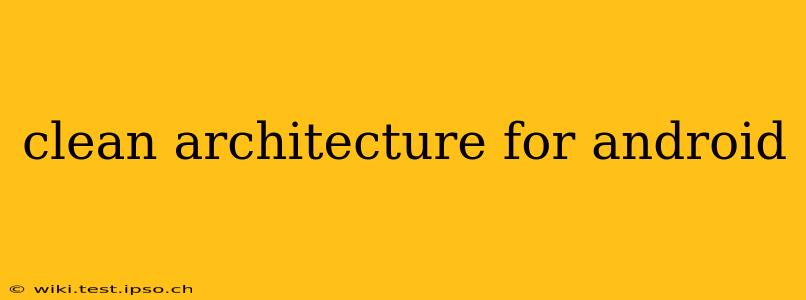Clean architecture is a software design philosophy that emphasizes separation of concerns, testability, and independence from frameworks. For Android development, adopting clean architecture leads to more robust, maintainable, and scalable applications. This article dives deep into the principles of clean architecture for Android, exploring its benefits and practical implementation. We'll also address common questions developers have about this approach.
What is Clean Architecture?
Clean architecture, as popularized by Robert C. Martin (Uncle Bob), promotes a layered structure where the core business logic is independent of external frameworks like Android SDK, databases, or UI elements. This independence makes the codebase highly testable, reusable, and adaptable to changes. The core layers are typically organized as follows:
-
Entities: This inner layer contains the core business logic and domain objects. These are pure data structures and business rules independent of any framework or infrastructure. Think of them as the fundamental building blocks of your application.
-
Use Cases: This layer interacts with the entities to perform specific business operations. It orchestrates the flow of data and logic, making use of the entities to achieve specific tasks. These are often called "interactors" in the Android context.
-
Interface Adapters: This layer translates data between the use cases and the presentation layer (UI) or data sources (databases, network). It's responsible for converting data into a format suitable for each layer. This is where you handle things like data mapping and presentation logic.
-
Frameworks and Drivers: This outer layer consists of frameworks, databases, UI, and other external components. It's where you interact with the Android SDK, network APIs, and other external dependencies.
Why Use Clean Architecture in Android Development?
Adopting clean architecture in your Android projects offers several significant advantages:
-
Testability: The separation of concerns allows for easy unit testing of the core business logic without needing to set up mock Android components.
-
Maintainability: Changes in one layer are less likely to impact other layers, simplifying maintenance and updates.
-
Reusability: The core business logic can be reused across different platforms or applications.
-
Independent of Frameworks: The core business logic remains unaffected by changes in the Android SDK or other external frameworks.
-
Improved Code Organization: The layered approach results in a more organized and understandable codebase.
How to Implement Clean Architecture in Android
Implementing clean architecture typically involves using dependency injection to manage the flow of data and dependencies between layers. Popular DI frameworks like Dagger/Hilt are commonly used.
Example Structure (Simplified):
├── app/
│ ├── src/
│ │ ├── main/
│ │ │ ├── java/
│ │ │ │ └── com/
│ │ │ │ └── example/
│ │ │ │ ├── entities/ // Entities (domain models)
│ │ │ │ ├── usecases/ // Use Cases (interactors)
│ │ │ │ ├── data/ // Repositories, Data Sources
│ │ │ │ ├── ui/ // Presenters, ViewModels, Activities, Fragments
│ │ │ │ └── di/ // Dependency Injection modules
│ │ │ └── ...
│ └── ...
What are the common challenges of implementing clean architecture in Android?
H2 What are the benefits of using Clean Architecture in Android development?
The benefits are numerous and contribute to building high-quality, sustainable applications. Firstly, testability is greatly improved. You can unit test your business logic independently of the Android framework, leading to more robust and reliable code. Secondly, maintainability is enhanced because changes in one layer are less likely to ripple through the entire application. Thirdly, the reusability of core components increases, meaning you can leverage your business logic in other projects or contexts. Finally, the architecture provides a clear separation of concerns, leading to cleaner, more organized code, and easier collaboration within development teams.
H2 How does Clean Architecture improve code quality in Android projects?
Clean architecture leads to better code quality through several mechanisms. The primary way is through the separation of concerns. Each layer has a specific responsibility, preventing code bloat and making individual components easier to understand, test, and maintain. This results in reduced complexity and improved readability. The decoupling also improves modularity, meaning changes in one area don't affect others unnecessarily. With increased testability, the overall reliability of the application is heightened, and the chances of introducing bugs decrease. The outcome is a higher quality, more maintainable, and more robust Android application.
H2 How does Clean Architecture relate to other architectural patterns like MVVM or MVP?
Clean architecture isn't a replacement for architectural patterns like MVVM or MVP; instead, it's complementary. Clean architecture defines the layers and their interactions, while MVVM or MVP dictates how the presentation layer (the UI) is structured. You can use Clean Architecture with either MVVM or MVP (or even MVI). In a typical implementation, the ui layer of Clean Architecture would utilize the chosen presentation pattern (like MVVM) to manage UI updates and user interactions. Essentially, Clean Architecture focuses on the higher-level structure, while patterns like MVVM handle the UI-specific logic.
H2 What are the best practices for implementing Clean Architecture in Android?
Effective implementation requires careful planning and adherence to best practices. Using a dependency injection framework (like Dagger/Hilt) is crucial for managing dependencies between layers. Strictly adhering to the separation of concerns is paramount—ensure each layer fulfills its defined responsibility without venturing into other layers' territory. Write unit tests extensively to ensure the correctness of your business logic. Choose a suitable presentation pattern (like MVVM) to effectively manage the UI layer. Finally, start small and iterate—it's better to begin with a simplified implementation and gradually add complexity as needed.
This comprehensive guide provides a strong foundation for implementing Clean Architecture in your Android projects. Remember that the key is a well-defined separation of concerns and a clear understanding of each layer's responsibilities. By following these principles, you can create Android applications that are more robust, maintainable, and scalable.
